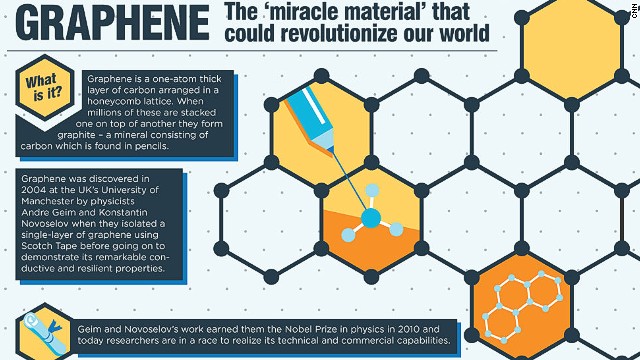Graphene is the thinnest substance ever created, is as stiff as a diamond, and is hundreds of times stronger than steel. It is flexible, stretchable, and conducts electricity faster at room temperature than any other material. It can even convert light at any wavelength into a current. It has many potential applications such as faster computer chips, flexible touch-screens, and efficient solar cells. Graphene has one major flaw however; it is unsuitable for the binary on/off mechanisms that are fundamental for electronics. It is difficult to make in quantity as the single sheet of carbon atoms in a hexagonal honeycomb shape requires rigorous attention to detail else tears will occur.
The European Commission in Brussels approved a graphene flagship project in January which is a joint effort between industry and academia. Several researchers have expressed concern of the size of the project stating that it will inevitably be fettered by the bureaucracy of a venture of such magnitude. The flagship programme is divided into 16 separate work packages that are focused on developing technologies in separate application areas. Production of graphene using the surefire method (2010 Nobel Prize worthy) is far too slow and can cost over $1,000 per micrometre flake. Graphene has already seen applications such as enhancing tennis racket strength and in conductive circuits but this is in an impure, weaker form.

Graphene potentially can revolutionize the computer world with its clocked 400 gigahertz speeds, far more than comparable silicon devices. Europe has been the leader in academic research with scientists coming from many countries but Chinese, Japanese, South Korean, and American companies leading in development. The European Commission wants the flagship to be as inclusive as possible to ensure that the under-represented members can be a part of the action. The consequence is that existing research groups are barred from bidding for funds which greatly limits what already successful groups can achieve. Researchers prefer cohesive teams in which results can be shared among all members. When funds are split among multiple groups that each have their own agenda, progress is halted for the sake of fairness.
The way electronics are thought about will have to radically be changed in order to incorporate graphine into itself. The cost barrier definitely is slowing down development but techniques have risen to make production more affordable and with time and research I am sure that costs will decline. It will be interesting to see whether silicon valley opens up to the idea of being called graphene valley someday.
src: http://www.nature.com/news/graphene-the-quest-for-supercarbon-1.14193
No comments:
Post a Comment